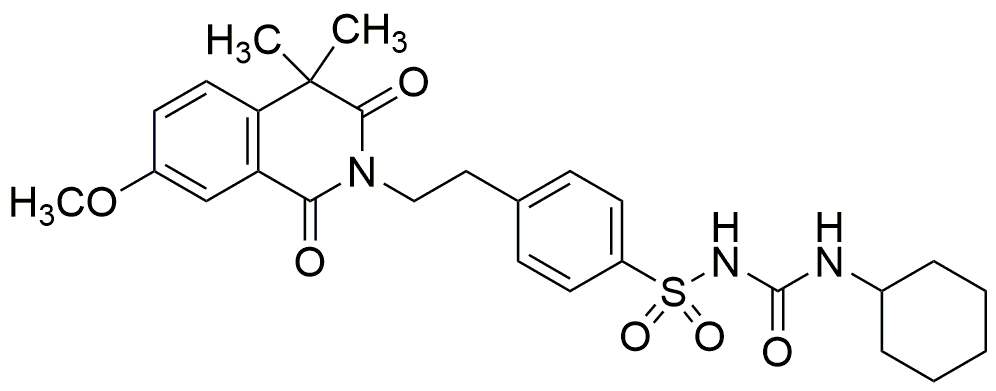Gliquidone is widely utilized in research focused on:
- Diabetes Management: As an oral hypoglycemic agent, it helps control blood sugar levels in patients with type 2 diabetes, making it a vital option for endocrinologists and healthcare providers.
- Pharmaceutical Development: Researchers explore its efficacy and safety profiles in clinical trials, contributing to the development of new diabetes medications and treatment protocols.
- Combination Therapies: Gliquidone is often studied in combination with other antidiabetic drugs to enhance therapeutic outcomes, providing insights into multi-drug regimens for better patient management.
- Metabolic Research: It serves as a model compound in studies examining insulin sensitivity and resistance, aiding researchers in understanding metabolic disorders.
- Formulation Science: The compound is used in the development of novel drug delivery systems, improving the bioavailability and effectiveness of diabetes treatments.
General Information
Properties
Safety and Regulations
Applications
Gliquidone is widely utilized in research focused on:
- Diabetes Management: As an oral hypoglycemic agent, it helps control blood sugar levels in patients with type 2 diabetes, making it a vital option for endocrinologists and healthcare providers.
- Pharmaceutical Development: Researchers explore its efficacy and safety profiles in clinical trials, contributing to the development of new diabetes medications and treatment protocols.
- Combination Therapies: Gliquidone is often studied in combination with other antidiabetic drugs to enhance therapeutic outcomes, providing insights into multi-drug regimens for better patient management.
- Metabolic Research: It serves as a model compound in studies examining insulin sensitivity and resistance, aiding researchers in understanding metabolic disorders.
- Formulation Science: The compound is used in the development of novel drug delivery systems, improving the bioavailability and effectiveness of diabetes treatments.
Documents
Safety Data Sheets (SDS)
The SDS provides comprehensive safety information on handling, storage, and disposal of the product.
Product Specification (PS)
The PS provides a comprehensive breakdown of the product’s properties, including chemical composition, physical state, purity, and storage requirements. It also details acceptable quality ranges and the product's intended applications.
Certificates of Analysis (COA)
Search for Certificates of Analysis (COA) by entering the products Lot Number. Lot and Batch Numbers can be found on a product’s label following the words ‘Lot’ or ‘Batch’.
*Catalog Number
*Lot Number
Certificates Of Origin (COO)
This COO confirms the country where the product was manufactured, and also details the materials and components used in it and whether it is derived from natural, synthetic, or other specific sources. This certificate may be required for customs, trade, and regulatory compliance.
*Catalog Number
*Lot Number
Safety Data Sheets (SDS)
The SDS provides comprehensive safety information on handling, storage, and disposal of the product.
DownloadProduct Specification (PS)
The PS provides a comprehensive breakdown of the product’s properties, including chemical composition, physical state, purity, and storage requirements. It also details acceptable quality ranges and the product's intended applications.
DownloadCertificates of Analysis (COA)
Search for Certificates of Analysis (COA) by entering the products Lot Number. Lot and Batch Numbers can be found on a product’s label following the words ‘Lot’ or ‘Batch’.
*Catalog Number
*Lot Number
Certificates Of Origin (COO)
This COO confirms the country where the product was manufactured, and also details the materials and components used in it and whether it is derived from natural, synthetic, or other specific sources. This certificate may be required for customs, trade, and regulatory compliance.

